Investigating the Galaxy Nexus LTE Signal Issue
by Brian Klug on December 19, 2011 8:24 PM EST- Posted in
- Smartphones
- Verizon
- LTE
- Droid Charge
- Mobile
- galaxy nexus
- Android 4.0
It seems that each time an LTE handset comes out, there’s invariably some perceived issue with connectivity and stability. This time, focus is being placed on Verizon’s CDMA/LTE variant of the Galaxy Nexus, and the issue surrounds LTE connectivity robustness compared to the other LTE handsets out there.
I’ve been running battery life tests on our LTE Galaxy Nexus review unit since release day (a process that takes a considerable amount of time and results in our reviews posting a while behind everyone else’s), but have had some time to run tests and gauge subjective performance. I found that LTE connectivity and performance felt above average, subjectively, and noted that in a tweet. After complaints started to surface, I spent a considerable amount of time reading the threads on XDA and other places around the web trying to discern what the complaints are about. I’ve seen a couple of big misconceptions that I think really get to the heart of the matter.
First off, is some background. The Verizon CDMA/LTE Galaxy Nexus (codename “mysid”) uses a combination of Samsung CMC221 and Via Telecom CBP 7.1 for LTE and CDMA 1x/EVDO connectivity, respectively. This is virtually identical (unsurprisingly) to the Droid Charge, which used a CMC220 for LTE and the same CBP 7.1. The CMC22x family is UE Category 3, which currently is the highest for shipping devices and means it can handle up to 100 Mbps downstream with 20 MHz FDD. To date, all of the LTE basebands in Verizon LTE devices have been UE category 3 with the exception of Motorola’s devices, which are all UE category 2, but I digress. We’ve reached out to Samsung Semiconductor about what’s changed between CMC220 and 221, but doubtless the changes improve connection stability and reliability.
Speeds thus far have also been excellent. I’ve squeezed in 183 speedtests between battery life testing, and have seen some of the fastest LTE connectivity out of the Galaxy Nexus to date. After testing so many Motorola LTE devices with UE Category 2 modems, it’s refreshing to see this kind of performance out of a UE Category 3 device.
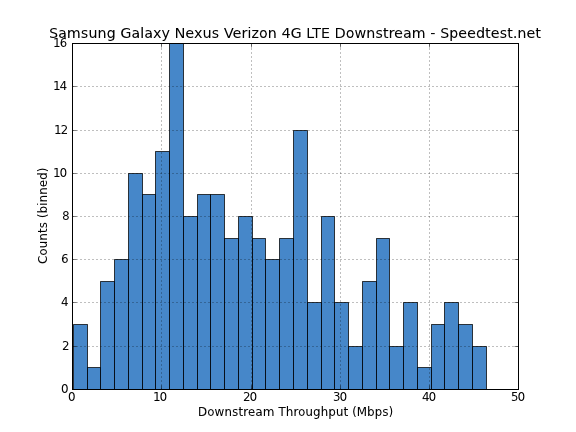
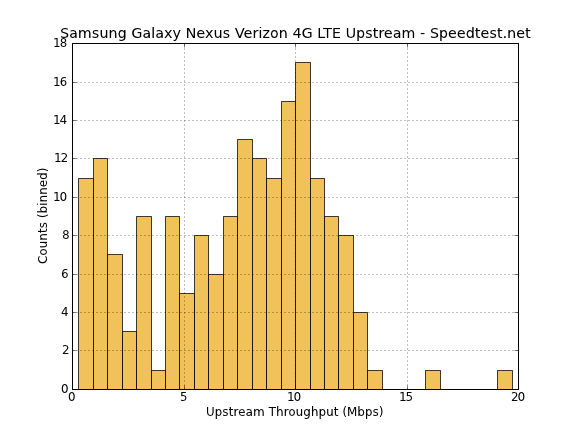
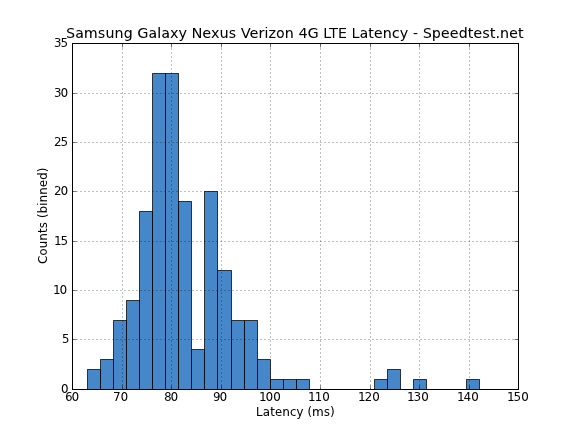
The issue that most people talk about centers around signal strength, and this is where a few misconceptions kick in. I’ve gotten a few emails and tweets and read pages on forums where people are implicitly comparing CDMA2000 1x/EVDO field strength to LTE field strength. The issue here is that on basically all of the LTE/CDMA Verizon handsets, the field under “Signal Strength” in about refers to EVDO signal strength, and not LTE signal strength. The two aren’t comparable at all for a host of reasons - different spectrum (800 MHz and 1900 MHz for 1x/EVDO as opposed to 700 MHz for LTE), and different cells (there’s some correlation, but not every Verizon base station has LTE onboard). The end result is that if you’re comparing 1x/EVDO signal strength to LTE signal strength, you’re making an absolutely meaningless apples to oranges comparison.
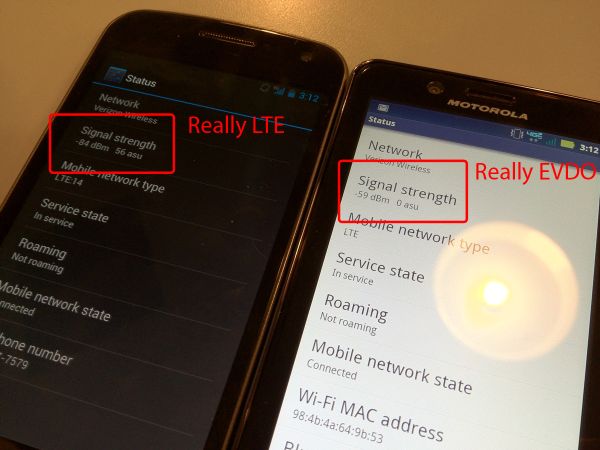
This is not a valid comparison - LTE versus EVDO signal strength
The Galaxy Nexus (and really just Android 4.0) now correctly reports and accommodates LTE by reporting its signal strength under “About->Status” and visualizing that as bars appropriately. Switch to EVDO on the Galaxy Nexus and signal strength appropriately changes to reflect an entirely different air interface’s signal strength. It’s nice to see people using dBm instead of bars when possible (which are effectively meaningless as a comparison metric), but now that there are multiple air interfaces on handsets, we have to be explicit about what numbers we’re actually comparing.
This reporting is a problem I’ve talked about at length in more than one LTE handset review, and to date I only know of ways to show LTE signal strength and channel quality on a few handsets. Samsung’s Droid Charge (courtesy Samsung’s excellent ServiceMode application viewed through *#0011# after some unlock trickery) and the Bionic (through logcat and grepping for the radio signal status daemon) report LTE field strength, but only if you dig for them.
Comparing LTE Signal Strength the Right Way
So how does the LTE Galaxy Nexus compare to the Droid Charge and Bionic, the two handsets we can actually view LTE signal strength in dBm on? Very closely as a matter of fact.
I have a Bionic kicking around which has to go back very soon, but fired up logcat and put the Galaxy Nexus next to it. The Bionic reports signal strength pretty constantly whereas in Android 4.0 the number has some hysteresis, but here the numbers are pretty darn close, with the Bionic hovering between -91 and -95 dBm, and the Galaxy Nexus reporting an average of -92 dBm.
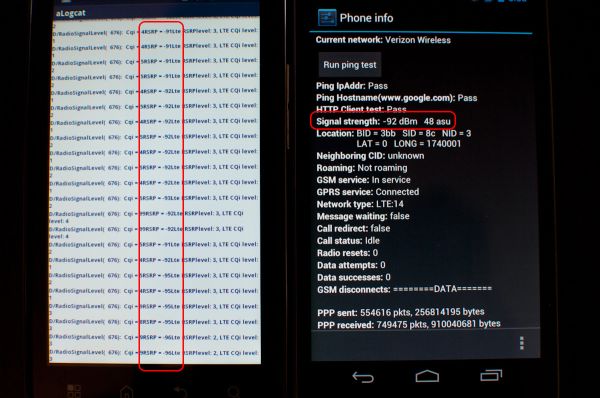
Left: Motorola Droid Bionic (logcat showing LTE signal strength), Right: Galaxy Nexus
Since the Droid Charge is the only other handset I know how to show LTE signal strength on, I tracked a friend down at a local cafe with one and fired up service mode. Again, what’s shown under “About->Status” on the Droid Charge is actually EVDO signal strength. Here the Galaxy Nexus shows -107 dBm and the Droid Charge shows -108 dBm.
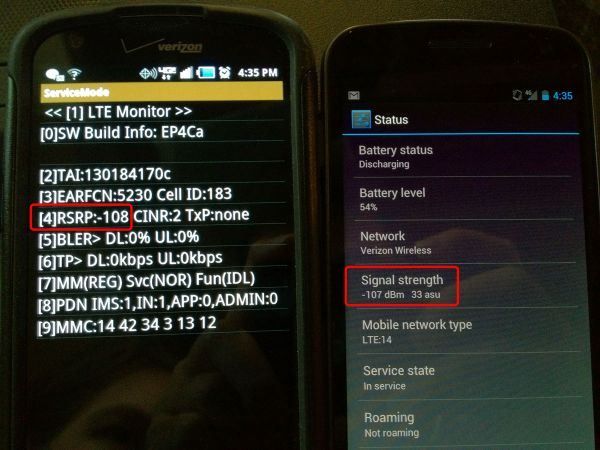
Left: Samsung Droid Charge (ServiceMode) Right: Galaxy Nexus
The Droid Charge is another hilarious example of why you can’t compare bars at all, as the Charge shows a positively laughable 4 out of 5 bars in an area with very low LTE signal strength, whereas the Galaxy Nexus (moreover, Android 4.0) has a very conservative and realistic strength to bars mapping. Carriers love to make things out to be better than they really are, however, and the result is this kind of hilarious visualization which portrays LTE signal as being much better than it really is if you stare at bars all day.
Verizon confirming though a tweet that there’s some sort of signal issue affecting the Galaxy Nexus confuses me, since from my perspective there isn’t any issue at all. The only real issue that exists is that the Galaxy Nexus (and really just the stock Android 4.0 signal strength to bars mapping) doesn’t line up with what Verizon has shipped on other devices, thus leading people to make apples to oranges comparisons and imagine an issue. I wager that some of this confusion is also compounded from the number of Verizon customers that are just now getting their first LTE handset with the Galaxy Nexus. It might be surprising to discover that LTE coverage right now isn't nearly as good as 1x/EVDO, but these things will improve as the carrier's LTE rollout continues. The other big disclamer is that I haven't fully investigated 1x/EVDO performance on the Galaxy Nexus, but this will end up being virtually identical to the Droid Charge.
There’s a CDMA and LTE baseband update coming with the LTE Galaxy Nexus’ 4.0.3 update as shown above, but this will likely do more to address connection stability than change the way anything is reported. Given how much attention this has gotten, however, I would not be surprised to see Google make a change to its signal strength to bars mapping for LTE and placebo away an issue that never really existed to begin with. That's also an unfortunate change, since from my perspective the Galaxy Nexus is one of the first handets that doesn't have an unrealistic mapping. In the meantime, we're still working on our Galaxy Nexus review where we'll take a complete look at the LTE/CDMA and GSM/UMTS Galaxy Nexii.
Update:
As predicted, Verizon has made a statement to The Verge and Computerworld stating that there's nothing wrong with the RF performance characteristics or baseband firmware on the LTE/CDMA Galaxy Nexus. Instead, they will upstream some changes to Android to make the device report its bars visualization in line with the rest of its 4G LTE hardware portfolio.
"[Verizon] will adjust the signal strength indicator to more closely match other Verizon Wireless devices.


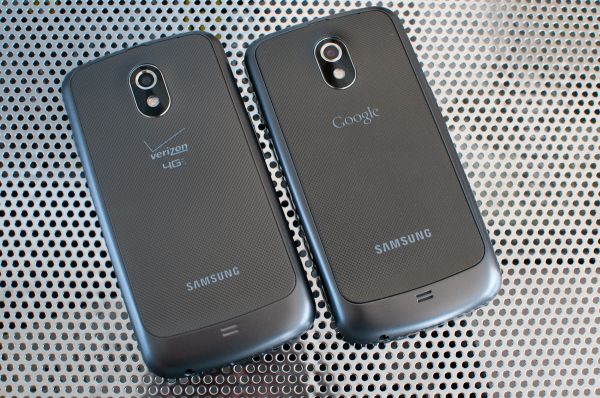









154 Comments
View All Comments
FreeAintFree - Tuesday, December 20, 2011 - link
This is good news. At least there doesn't appear to be some inherent problem with Galaxy Nexus. Not yet. I'm happy because I really like the phone.Comparing 3G only signal between razr and gnex (I have both) and the comparison is much closer. More testing will be needed to determine if the gnex can hold "service" in all the same places as the razr.
But for now at least, I think we can stand down with regard to some inherent defect in gnex signal sensitivity. Time will tell if it's above par or below.
Conficio - Tuesday, December 20, 2011 - link
Brian,thanks for trying to clarify a difficult issue here.
However, I can't say it is helpful to set you own opinion based on a single device and defend it against everybody else, even Verizon's own Teet. You are a reporter, and a good one at that, but don't feel like your observation needs to be proven right.
I'd rather have you educate and ask people what they really compare as to educate about the issue. You loose your objectivity if you try to be right, rather than reporting the truth and clarifying your statements.
Kaj
Happy Holidays all at Anandtech, authors, reporters, editors and readers and a Happy New Year!
rothnic - Tuesday, December 20, 2011 - link
Did you get a chance to investigate the handover between 3g/4g. I've seen much of the signal level talk and I haven't really had a problem with that. The issues I've seen a lot of people mention is handover.I will have a lowish 4g signal at work that works a good bit of time. However, when it goes to switch to 3g it seems like it has trouble actually initiating the data connection. This same location my droid x seemed to never have an issue with 3g. Anytime it is going to/from 3g/4g the issue to me is more initiating the data connection with the tower.
I've seen many reports of people having to toggle airplane mode to get it to reestablish a connection. Since after toggling, it connects right up, obviously there is some connection stability issue. I've seen more people complaining about this compared to the actual signal level. I think people suspected signal level and started comparing after dealing with the stability issue. It seems you have debunked their initial theory, but what is the next step?
rothnic - Tuesday, December 20, 2011 - link
To follow up....This happened again this morning:
1) Working with 2 bars of 4g
2) Go to update a twitter widget and see it has dropped to 3g
3) Later do the same and see the grayed out 3g icon, then no signal at all
4) Sits with no signal at all, notification menu says "searching for signal"
5) Wait awhile longer, and decide to toggle airplane mode after having no signal for 5+ minutes
6) Airplane mode is shown in top bar, but is grayed out so I can't switch back off
7) Reboot phone
8) On reboot, instantly get 2 bars of 4g
This is my lifecycle of use for this phone. Not a low signal level, but instable 3g and 4g connections and handover
Mastibeta - Tuesday, December 20, 2011 - link
I can see where their strengths may actually be the same. The issue i have, is how the device actually chooses which network to be on. In my office, a Razr will connect to 4g and maintain 4g speeds, but my Nexus will connect for a few minutes after an airplane mode cycle...then drop down to 3g. So even thought the 4g network is available to the nexus...at the same strength as the Razr, it reverts to 3g...why?rothnic - Tuesday, December 20, 2011 - link
Exactly. The Nexus will drop down to 3g when 4g is available, and fairly often when it goes to switch to 3g it seems it fails to connect. Then I get either the grey colored 3g bars, or it will drop all connections and show no signal at all. Then you can try to toggle airplane mode to bring it back.northamerican - Tuesday, December 20, 2011 - link
I have both the Samsung Droid Charge running 2.3.6 version and the Galaxy Nexus.I have both phones opened to phone status and the -dbm readings average about 10 points difference.,If the galaxy is at -93 dbm, the charge reads -83!I have pictures of this and it's pretty much constant.I wonder if the receiver is more robust on the Charge?It definitely gets a higher -dbm level with the 2 phones right next to each other or 20 feet apart.I'm willing to document this however that is done.
northamerican - Tuesday, December 20, 2011 - link
How do I upload the pictures to you?SmokeNMirrors - Tuesday, December 20, 2011 - link
One thing I haven't seen referenced yet, while the Charge and Nexus may use nearly identical radios, they may not have the same antennae or internal layout. This can be every bit as much an influence as the radio chip set in signal strength.qualm - Tuesday, December 20, 2011 - link
Brian,What about wifi connectivity? My girlfriend has a HTC Droid Incredible 2 and sitting in the same spot I barely get a connection on my Galaxy Nexus pulling down 3mbp, her phone does 15mbps. Standing right next to the router I can get a great signal and great speeds, but as soon as I walk away the reception drops drastically. As soon as 7 feet or so you notice a drop in signal strength and mbps download speeds. 10 to 15 feet away and I am having connectivity problems and down to 1 - 3 mbps. Every other object in my house connects and stays connected. (2 laptops, PS3, ipod, HTC Droid Incredible) It seems that my Nexus does terrible compared to all these other devices. That was how I noticed that it seemed the reception, on the Nexus, was not great at all. Also on Androidforums.com there are reports of people forcing 3g and getting crappier reception than other 3g devices.
Thanks for looking into this.